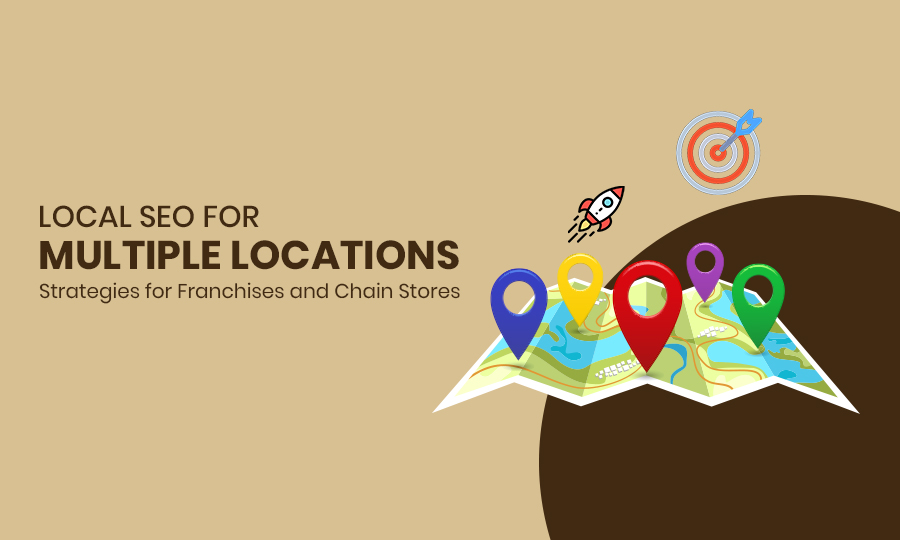Did you know that 46% of all Google searches are to find local businesses? So, if you own franchises or are a part of chain stores, you need to reach out to a wider customer base at multiple locations. Moreover, 76% of users search online on their mobile devices and visit a local store within a day. And research says that almost 28% of customers purchase from that particular store. Therefore, local SEO for multiple locations is so important for multi-location businesses like franchises and chain stores.
In this internet era, if you are not optimizing your local visibility online, you probably miss out on a huge customers. To dominate the local market, first, you need to optimize your website with local search engine optimization. As franchise businesses or chain stores are spreading in various locations, you have to incorporate a multi location seo strategy.
Don’t worry, in this blog, you will have a comprehensive guide on how you attract local customers to various business locations. Moreover, how to take advantage of multiple business listings and get the 14 most innovative local seo strategies for multiple locations.Also, the technical guidance, like how you maintain your page speed and search rankings, and so on.
Let’s delve deeper and find out the various ways to hold the local search results and acquire the attention of local customers.
What Is Local SEO for Multiple Locations and Why Does It Matter?
Before going to the most important strategies of local SEO, you have to understand what actually local SEO stands for. Basically, multi-location local SEO increases your brand’s local search results. The local SEO business is worth more than $80 billion. Most of the business giants have confirmed the significance and influence of local SEO.
Imagine a brand like Domino’s Pizza. It has hundreds of outlets, but you can think of it like you’re craving pizza and you type “Domino’s near me” into Google; you want to find the nearby store location, not one from another city. That’s the objective of multi location SEO—it will make your franchise or chain store pop up in searches for its particular location.
If a brand doesn’t have a multi-location SEO strategy, local customers may only see its main website instead of its nearest branch. So for each location, franchises and chain stores should capitalize on local SEO to target the right audience.
Multi-Location vs. Single-Location Businesses
- Single-location business: A local shop, restaurant, or service that operates from one physical location. It only needs one Google Business Profile listing, one set of local business listings, and one suitable local landing page.
- Multi-location business: A brand that operates in multiple locations, like chain stores, franchises, or multi-location brands. These companies require distinct Google Maps optimization, location-specific websites, and uniform local listings across all of your locations.
However, it’s hard to maintain content accuracy and consistency across all locations. Maybe there is some duplicate content, but you need to take extra care to resolve it. You need to track all updates and changes that happen in multiple locations to ensure all information is up-to-date and precise.
Top 5 Benefits of Local SEO for multiple locations for Franchises & Chain Stores
- Improved Local Visibility—It’s easy for people in the area to find the store closest to them because each branch shows up in local searches. 40% of local SEO campaigns deliver a return of 500% or more.
- Higher Search Engine Rankings—Most of the franchises and chain stores get more free traffic from search engines when you develop different location pages with perfect keywords.
- Better Customer Experience—You need to add authentic business hours and open timings to inform your customers. When you optimize your Google Business Profile, it will automatically show all the data you’ve input regarding your business.
- More Conversions from Local Search— The conversion rate of local leads to sales is significantly higher than that of general marketing leads. Furthermore, more than 80% of local searches lead to sales, while only 2-3% of normal online ads do the same. That’s a substantial advantage in marketing ROI!
- Adjustable Multi-Location Marketing- Multi-location businesses can manage their different locations safely with the right SEO strategy. You have to personalize each location page with specific keywords and business information to improve rankings and attract more local customers. This targeted approach can lead to higher conversion rates and overall success in local search marketing initiatives.
Local SEO for Multiple Locations: 14 Proven Strategies for Franchises and Chain Stores
In this segment, you will get the most useful 14 local SEO strategies for multiple locations.
- Optimize a Google Business Profile for Each Location
Google gives ranking preference to businesses with comprehensive business information on their profiles. So, you need to update your Google Business Profile with fresh content to expand visibility and engagement. Almost 64% of consumers have looked to Google Business Profile for contact information. Your profile serves as the primary contact directory for customers.
So, let’s learn how to set up a perfect Google Business Profile –
Step-by-Step: Single Location-specific pages
First, you have to use a Google account (prefer a business / shared account). Go to business.google.com and click “Start now.”
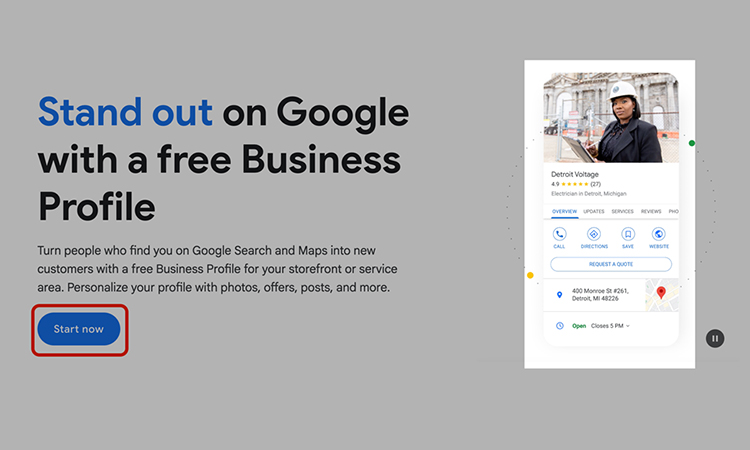
Then Add Your business name –
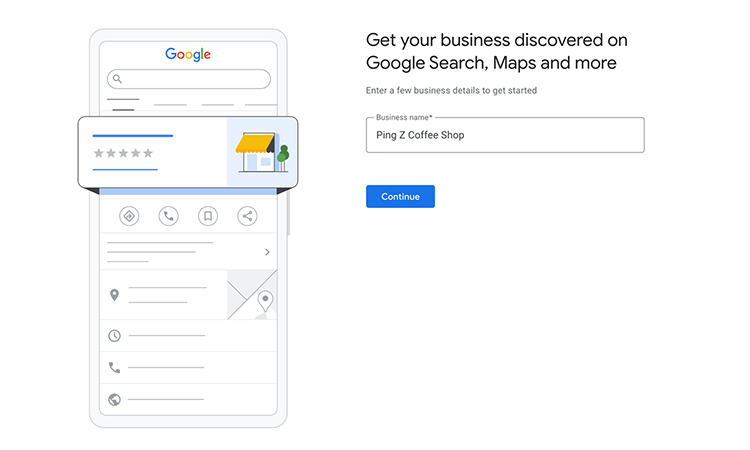
Select your business type carefully.
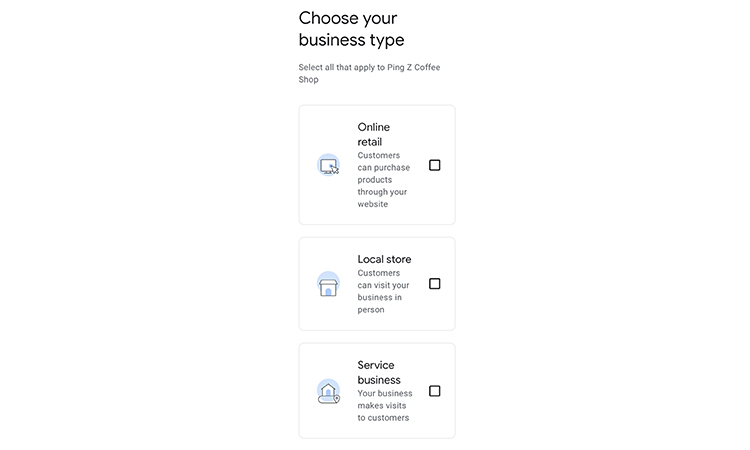
Add your busisness catagory, I am just showing how it pops up. Choose your business niche.
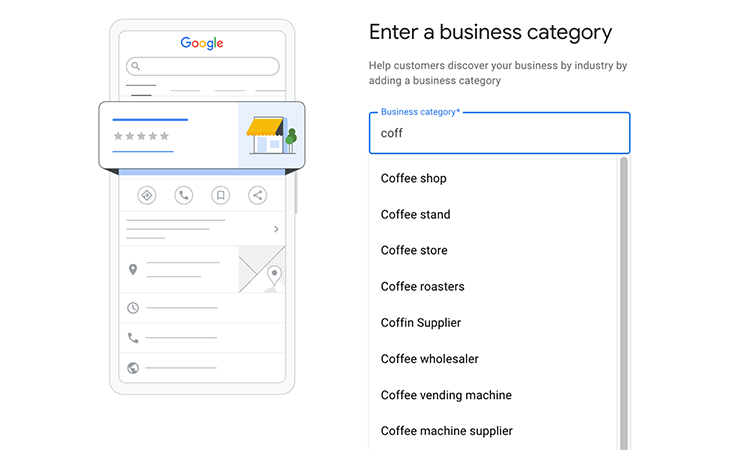
Then add your business address very carefully. Give every detail.
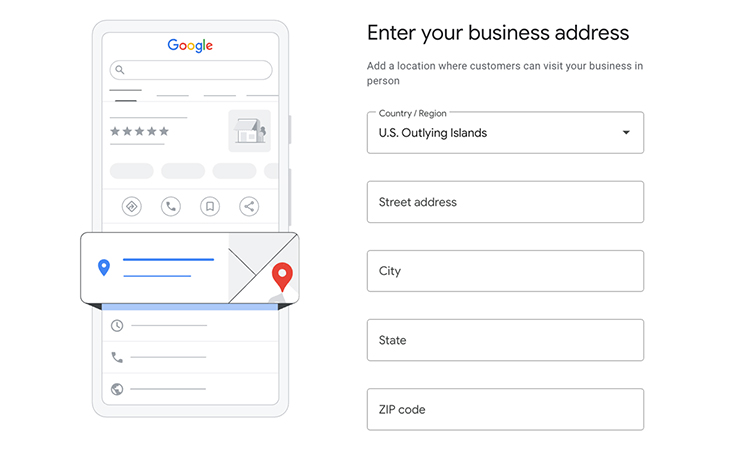
After that, choose your business location on the Google map.
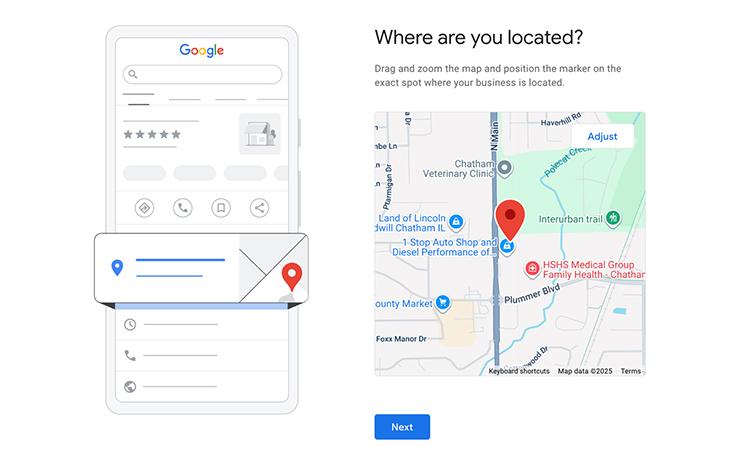
Add your contact information precisely.
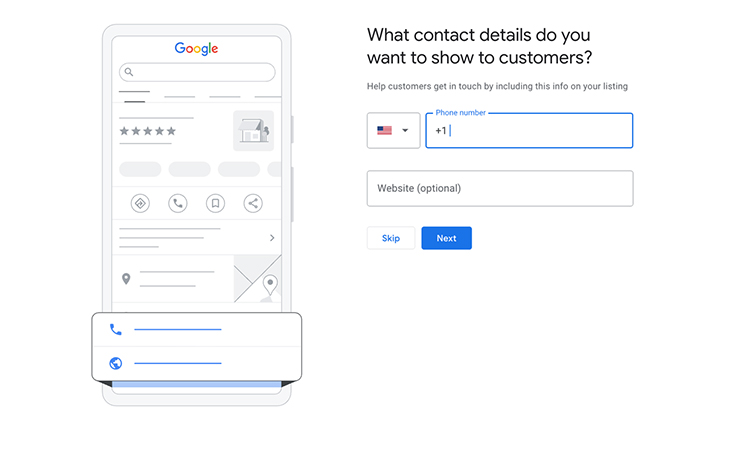
Moreover, carefully include your open and closing hours. If you miss anything, you may miss out on your potential clients.
Try to incorporate high-quality images of your franchise or chain store locator.
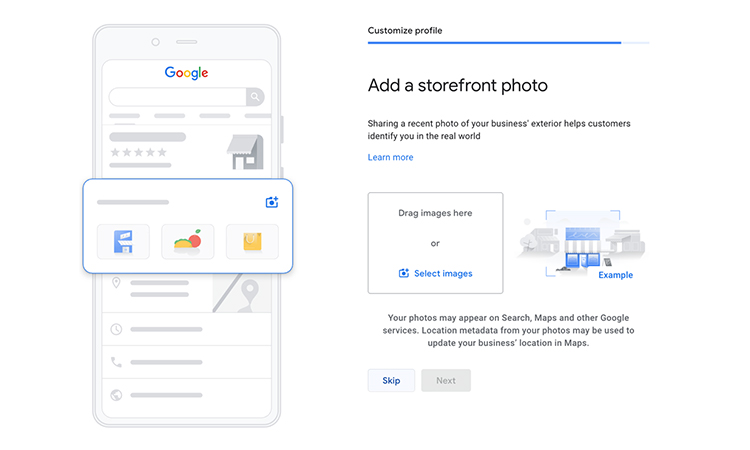
Then Google will verify your profile, and after 1 week or less, your business will be listed.
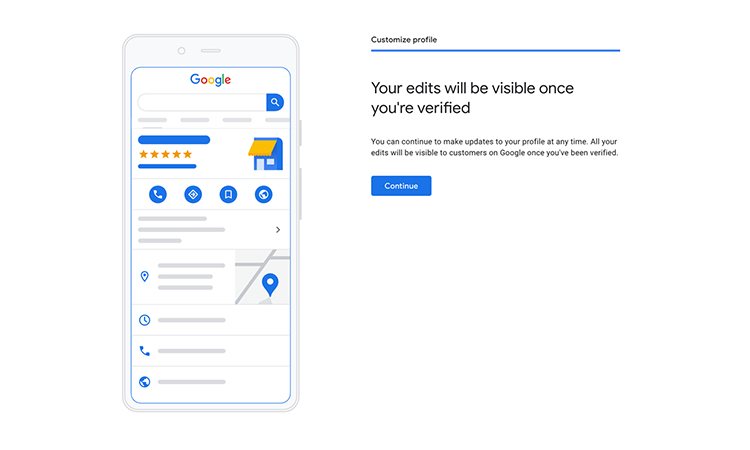
It’s also not necessary to have a different Google Business Profile (GBP) account for every location.
Here’s how it works:
- You make one main account for your business on Google.
- That account lets you add and handle more than one place, whether it’s 2 or 10 or more than 500.
- There is only one parent account for all of the locations, but each one has its address, phone number, business hours, and Google Maps pin.
- This is what Google calls “business groups” or “location groups.”
For instance, if you own Starbucks, you don’t make 10,000 separate Google accounts. Instead, you manage all store locations inside one GBP dashboard.
Tip: For 50+ locations, Google offers a bulk upload spreadsheet feature to save time.
Step-by-Step: Multi-Location (10+ stores / chain)
- Use Business Profile Manager
- Sign in to the same account and go to Manage locations. For 10+ locations, request bulk verification and use bulk tools.
- Google permits bulk management for businesses with 10+ locations.
- Prepare a Bulk Upload Spreadsheet
- Download Google’s template and fill required columns (name, address, phone, store_code, lat/long, category, hours, etc.).
- Ensure each location has a unique store_code to track updates.
- Import & Request Bulk Verification
- In Business Profile Manager, choose Import businesses → upload the spreadsheet.
- Then follow the bulk verification request flow (Google may ask for additional proof, like video or corporate docs).
- Verify & Clean Up
- Fix duplicates, confirm NAP consistency, and make sure each location meets Google’s guidelines before requesting bulk verification.
- Manage at Scale
- Use the manager to push updates in bulk (hours, photos, offers), but still create unique descriptions and photos per location to avoid duplicate content.
- How To Do Location-Specific Keywords Research?
Keywords are the specific search terms used by your target audience. So, you have to find out those keywords for your multi location SEO. Higher keyword rankings mean more visibility, more clicks, and usually more visitors finding your business online
Best Keyword research tools-
- Semrush – Keyword Magic Tool
- Ahrefs – Keywords Explorer
- Google Keyword Planner (Free)
- Answer The Public
- Mangools
- Ubbersuggest
I will demonstrate real-world examples using a fictional brand, “FreshBite Pizza,” which has locations in Phoenix, Austin, Denver, and Miami. So you can conduct keyword research for your franchises. You can use this simple, step-by-step plan that follows for any franchise or chain store with several locations.
First, you can start with Google Auto Complete. Just type your seed keyword in the Google search bar, and then explore search-related terms. Like this-
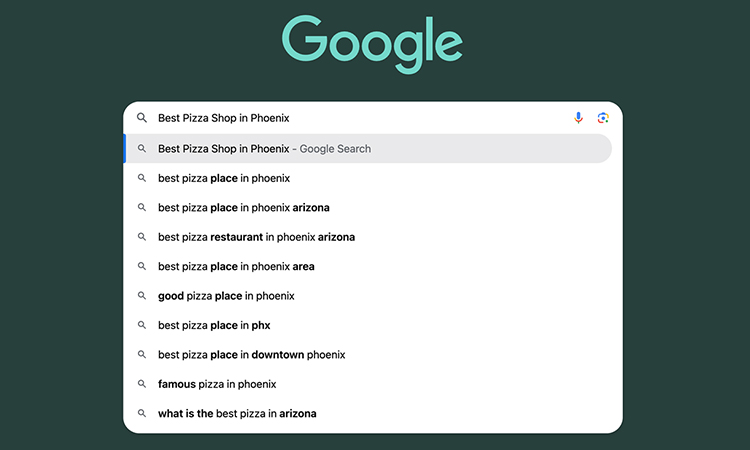
Then scroll down the Google first page and get these sections. Then figure out which local keywords you can pick for your specific local pages.
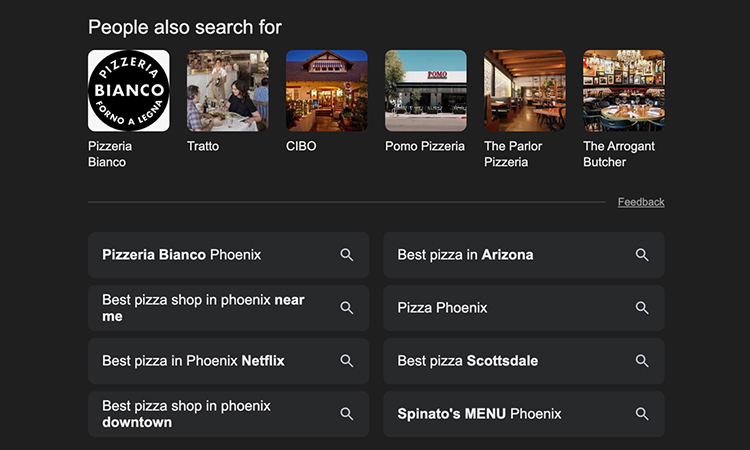
After that, you can check the “People Also Ask” section and get various questions. You can put these as FAQ(Frequently Asked Questions) in the local landing page or website.
Here, I am using Semrush to research local keywords for a coffee brand. You can follow these steps for your business niches.
Sign in to Semrush
Then, put your main keyword and set the specific location you want to spread your business.
And then you get this data. Go through the following table to choose relevant keywords-
| Metric | Definition (Simple English) | Tips for Using It |
| Keyword Volume | The average number of times people search for a keyword in a month. | Pick keywords with a mix of high volume (for reach) and low to medium volume (for easy ranking). |
| Global Volume | Total monthly searches for a keyword across the whole world. | Useful if your business targets multiple countries, not just local. |
| Keyword Difficulty (KD) | A score (0–100) showing how hard it is to rank on Google for that keyword. | Target low-to-medium KD (under 40) for new sites, and higher KD only if you have strong authority. |
| CPC (Cost Per Click) | The average amount advertisers pay when someone clicks their ad for that keyword. | High CPC means the keyword has money value — great for conversions, not just traffic. |
| Competitive Density | A measure (0–1 or 0–100) of how many advertisers are bidding on that keyword. | High density = more competition. Choose medium density to balance traffic and cost. |
Pro Tips:
- Balance volume & difficulty → don’t always chase the highest volume, focus on keywords you can rank for.
- Check CPC & density → if you plan ads, high CPC + high density = expensive, so budget wisely.
- Use local filters → always check location-specific search volume if doing Local SEO.
- Develop Your Location Landing Pages
If you own a franchise or chain store, your website should make it simple for local customers to find the closest location. This is where Local Pages, Landing Pages, and Location Landing Pages come in. Despite their similar names, they each play a distinct part in local SEO for several locations. Let’s understand with a comparison table:
| Feature | Local Pages | Landing Pages | Location Landing Pages |
| Purpose | Share store info for a specific business location | Drive conversions for a marketing campaign or offer | Combine store details with conversion-focused elements |
| Content Includes | Address, phone, hours, Google Maps, reviews | Offer details, CTA, form, testimonials | Store info + offers, Google Business Profile, CTAs |
| Target Audience | Local customers looking for nearby businesses | Visitors from ads or campaigns | Local customers who want both info and action options |
| SEO Value | Improves visibility in local search results | Limited SEO value (short-term use) | Strong SEO impact for multiple locations |
| Conversions | Low – mostly informational | High – designed for sign-ups, purchases | High – both store visits & online actions |
| Best For | Informing customers about store details | Ads, promotions, and lead generation | Franchises & chain stores managing multiple locations |
| Example | Starbucks Store Info Page | “20% Off First Coffee Order” Page | Domino’s Pizza Times Square Order Page |
Although landing pages and local pages are helpful on their own, location landing pages are the most useful multi-location SEO tactic. These pages give all the required information a client can ask for. You can improve your search engine rankings and get more organic search traffic through proper local landing pages. Each location’s webpage should include unique business information, such as address and business hours.
How To Develop a Location Landing Page (Step-by-Step)
- Define Goal & Key Performance Indicator
Goal: Your intention should be to get calls, directions, bookings, and orders through location landing pages.
Key Performance Indicators: Clicks-to-call, “Directions” taps, form submits, revenue, local rankings.
- Research Hyperlocal Keywords
You already know how to research keywords. So, now you need to do this-
- Find city/area terms + service modifiers (e.g., “dentist in Plano,” “24-hour dentist Plano”).
- Group by intent: Find us (near me, directions), Evaluate (best, reviews), Act (book, order).
- Collect Location Data (make it unique)
- NAP (Name, Address, Phone), business hours, service list, prices/offers.
- Neighborhood landmarks, parking, transit, accessibility, and payment types.
- 6–10 original photos + 2–3 recent reviews.
- Improve Your On-Page SEO for Location Landing Pages
To make a relevant local landing page, you need to optimize proper on-page SEO for franchises or chain stores. So, you need to develop perfect URLs for your site and then maintain structure (H1, H2….) and titles and so on. It will improve your local search rankings and multi-location SEO.
- The perfect URL for a landing page-
The Uniform Resource Locator, or URL, is the web address. This address your user puts into each bar to find your page or website.
- Homepage: https://example.com/
- Location landing page: https://example.com/locations/new-york/
For location landing pages, you should keep URLs clean, short, and
include the – city or location name + service keyword.
- The Innovative Titles For Your Local Landing Page
- Title Tag → What appears in Google search results (a blue clickable link).
- Should include service, city, and brand name.
- Keep it under 60 characters.
Example:
Best Pizza in Chicago | Tony’s Pizza
- H1 Title → The main heading on your page.
- It’s like your title tag, but a little simpler.
Example:
Tony’s Pizza—Fresh & Hot Pizza in Chicago
This is the most useful structure to improve local search rankings-
You can consider the following structure to create location-specific pages to optimize multi location SEO, so users and Google understand it.
Example Structure for a Location Page:
- H1 + USP (40–60 words)
- Primary CTA row: “Call,” “Directions,” “Book/Order”
- NAP block: address (link to Maps), phone (tel:), hours
- Map embed (Google Maps)
- Services/Products (city-specific copy 150–250 words)
- Local proof: reviews, photos, team/store shots
- Practical info: parking, transit, accessibility, neighborhoods served
- Offer/Promo (optional) + secondary CTA
- FAQs (3–5 local questions)
- Nearby locations (internal links) + store locator link
Include Meta Title and Meta Description To Improve Click Rates
Meta title formula (≤60 chars): Your meta title should be very location-specific and relevant to your products. You can create different meta titles for all your locations.
The ideal meta title should be within 55-60 characters.
For Instance- {Primary Service} in {City} | {Brand}
Meta description (≤155 chars): This is the summary of your web page content. Try to make it short and simple and include all location-specific keywords. Moreover, the perfect meta description can be within 155-160 characters.
Like this- Visit {Brand} in {City}. {USP}. Call {Phone} or get directions.
Why E-E-A-T Content Matters for Local Landing Pages
When you create a local landing page, Google does not only check your keywords. It also looks for E-E-A-T: Experience, Expertise, Authoritativeness, and Trustworthiness. These signals help Google decide if your page is useful and safe for users.
- Experience means showing that you really operate in that location. Add real photos of your store, staff, or customers. Write about local events you have joined.
- Expertise means showing you know your business. Share simple details about your services or products in that city. Explain how you solve local customer problems.
- Authoritativeness means other websites trust you. Add links from local directories, news outlets, or community pages. Positive online reviews also help show authority.
- Trustworthiness means giving correct and clear information. Always write your business name, address, phone number, and working hours. Keep them the same on your website and Google Business Profile.
You need to use short sentences for higher rankings. Moreover, you have to make the language simple so anyone can understand. Avoid long, complex words. Write like you are explaining to a friend.
This makes your local landing page clear, trustworthy, and ready to rank higher in local search results.
Write Unique, Localized Copy
- 300–600 words total; include 2–3 landmark/area mentions (e.g., “near Congress Ave, Austin”).
- Most importantly, you have to develop different content for individual location pages. Don’t copy-paste across cities—change examples, services emphasis, and photos.
You can use Word Counter to track your word limits like that-
It is very helpful to measure word or character count for the title and description, and also for large content.
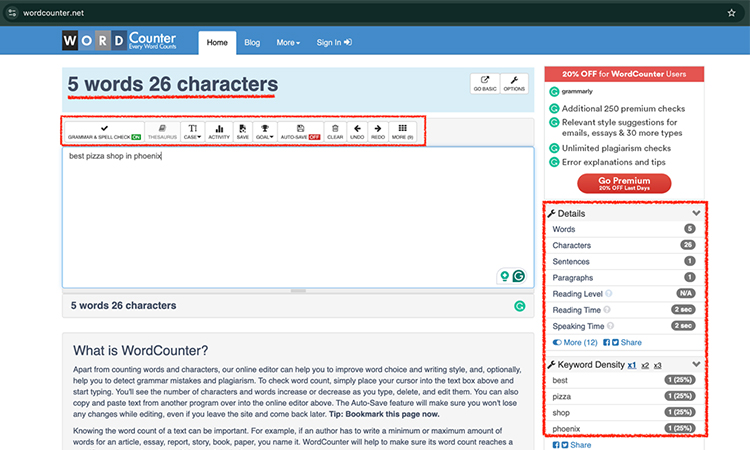
Your local landing page should be mobile-friendly
Most of your target audience opens web pages on their mobile. So you have to design your website or location-specific landing page for mobiles as well. It will improve your local SEO efforts.
You can follow these Essential Steps to Make Pages Mobile-Friendly
You need to develop an adjustable screen that goes well with phones, tablets, and desktops. This means that text, pictures, and buttons look great on any device, like an iPhone, Android.
- Remove unnecessary code and plugins.
- Use fast web hosting services.
- Enable browser caching.
- Keep paragraphs short (2-3 sentences).
- Add plenty of white space between sections.
- Choose high-contrast colors (dark text on light backgrounds).
- Make buttons at least 44px tall and wide.
- Space clickable elements far apart.
- You need to avoid hover effects that don’t work on touchscreens.
- Use hamburger menus for navigation.
- Limit menu items to 5-7 options.
- Make search bars easy to find.
Design and Development Tools
- Bootstrap – Framework that makes responsive design easy
- Figma – Design tool with mobile preview options
- Canva – Creates mobile-optimized images and graphics
- TinyPNG -You can use it to compress images without losing quality. This is best for optimizing web pages for smartphones.
WordPress Plugins (if using WordPress)
- WP Rocket – Speeds up page loading
- Smush – Automatically compresses images
- AMP for WP – Creates super-fast mobile versions
Advanced Tools
- BrowserStack – Tests your page on real mobile devices
- Hotjar – Shows how users interact with your mobile page
- Crazy Egg – Heat maps showing where mobile users click
Then You Need To Put Internal Links
- You can connect a city page to related category pages (e.g., “Dental Services in Dallas → Cosmetic Dentistry”).
- Then you may add links between nearby locations (e.g., “Visit our Houston branch”).
- This creates a local web of pages that search engines can use to find your business.
Canonical Tags
- Always add a self-referential canonical tag (points to its URL).
- Example: Dallas page → <link rel=”canonical” href=”https://example.com/locations/dallas/”>
- It helps you to eliminate duplicate content issues across multiple locations.
Schema Markup (JSON-LD)
Structured code called Schema Markup (JSON-LD) is added to a webpage to help search engines better understand its content, like reviews, events, or business information. This makes the webpage more prominent, improves its local SEO rankings, and improves its chances of appearing in rich search results.
- LocalBusiness (or subtype like Restaurant, Dentist) → add name, address, phone, hours.
- FAQPage → if you have FAQs.
- BreadcrumbList → shows navigation path. It helps users to find where they stand on the website and return to the home page.
Sample JSON-LD (You can edit placeholders):
You can take help from the Schema Tools
- Merkle Schema Markup Generator
- Schema.dev
Core Web Vitals: Step-by-Step Guide
These are Google’s key user experience metrics that directly affect multi location seo
1. Largest Contentful Paint (LCP) – Loading Speed
- What it measures: How quickly the main content (like images, headlines, banners) becomes visible.
- Good score: Under 2.5 seconds.
- Steps to improve:
- Use a fast hosting server (CDN like Cloudflare).
- Compress & serve images in WebP.
- Minimize unused CSS/JavaScript.
- Enable browser caching.
2. First Input Delay (FID) → now replaced by Interaction to Next Paint (INP) – Interactivity
- What it measures: How fast the page reacts when a user clicks, taps, or types.
- Good score: Under 200ms.
- Steps to improve:
- Minimize third-party scripts (like heavy tracking codes).
- Use async/defer for JavaScript.
- Break large JS tasks into smaller chunks.
- Use a lightweight theme for location landing pages.
3. Cumulative Layout Shift (CLS) – Visual Stability
- What it measures: Whether elements “jump around” while loading.
- Good score: Under 0.1.
- Steps to improve:
- Always set the width & height for images and videos.
- Reserve space for ads, popups, or iframes.
- Avoid inserting elements above existing content.
- Use a stable font load strategy (e.g., font-display: swap).
You can use these Tools to test Core Web Vitals
- Google PageSpeed Insights
- Lighthouse (Chrome DevTools)
- Google Search Console → Core Web Vitals Report
You need to frequently update your Local landing page
Always check past content and incorporate new offers and brand specifications. Moreover, you need to update hours/holiday hours, add new photos, answer reviews, refresh FAQs, check Core Web Vitals, verify map pin accuracy, and spot duplicate content.
- Local Business Listings and Local Listings for Discovery
There is a small difference between how SEO professionals talk about “local business listings” and “local listings.”
The following pictures show you how your business will be seen in the Yelp business profile. Your target audience can choose which segment they want, and then put location, and if you optimize your franchise or chain store properly, then you may pop up in these search results.
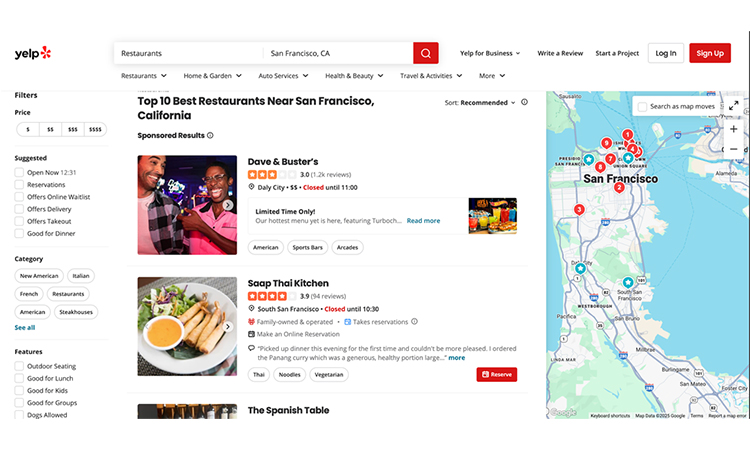
- Local Business Listing → A Google Business Profile listing for your Chicago branch is an example of a profile of a single business location on a directory or platform. It includes NAP (Name, Address, Phone), hours, website, photos, etc.
- Local Listings → If your business is listed on Google Maps, Yelp, Bing, Apple Maps, Justdial, and other sites, this is a more universal acronym for it. It’s the online community of listings that your business manages.
So:
- If you say “Manage Local Business Listing,” you handle one location’s profile (like updating hours on Google Business Profile).
- Furthermore, “Manage Local Listings” means taking care of all of your business listings across all platforms and locations, which is most important for franchises or chain stores.
Steps to Create & Manage Local Business Listings
1. Verify and Claim Listings
- You can start with Google Business Profile (You already know how to set up this profile at the top of my strategy list).
- Then, put in a claim on Yelp, Apple Maps, Bing Places, Facebook, Yellow Pages, and industry-specific directories
- Confirm ownership by phone, email, or postal mail.
2. Maintain Consistent and Accurate Information (NAP)
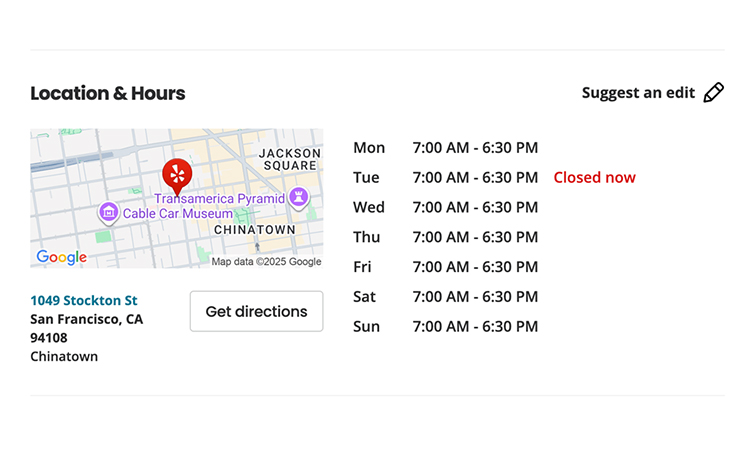
- The next step is to make sure that your company name, address, and phone number are consistent across all platforms.
- Mention business hours, services, website link, and categories.
- You should ensure reliability for all your locations. Otherwise, your target audience got confused.
3. Add Enriched Content With High Quality Photos
- Then you have to upload high-quality photos & videos of each store.
- Provide updates, offers, and local news.
- The ideal description should include keywords and location-specific data.
4. Collect & Manage Reviews
- Encourage local customers to leave reviews.
- Reply to reviews (positive & negative).
- More reviews = better local rankings.
5. Monitor & Update Regularly
- You can take help from tools like Moz Local, Yext, BrightLocal, and Semrush Listing Management to sync multiple locations.
- Adjust holiday hours, phone numbers, or services.
Evaluation Checklist
When choosing a tool, check if it offers:
- Bulk Features: It can help you adjust hundreds of locations at once.
- API Access: You can link with your CRM or internal systems.
- Audit Trails: Then you can monitor who modified what and when.
- Permissions & SSO: It will secure all access for employees or agencies.
- Security: Protect customer and business data. Data can be encrypted, and access controls can be set up to ensure the highest level of security.
Build vs. Buy
- Build in-house: This permits complete data ownership but comes with higher maintenance, ongoing expenses, and the need for developers.
- Buying from vendors: You can use automation tools like Yext, Moz Local, or Semrush Listing Management to save time, but they may lock you into one vendor.
Most multi location businesses, like franchises or chain stores, can save more money if they purchase a reputable tool. However, businesses with IT teams might look into custom installations. For smaller businesses, it may be more efficient to stick with manual management.
- How Do Reviews and Reputation Management Impact Multi-Location Rankings?
- Review management is only about customer reviews (collecting, monitoring, and responding on Google, Yelp, Facebook, etc.).
- Reputation management is the bigger picture—this includes managing reviews, mentions on social media, press articles, local news outlets, online forums, and even comparing your business to others.
So, reviews are just one part of reputation management.
More reviews → better search rankings → more customers → more reviews.
This cycle brings steady organic traffic to all your stores, helping the whole franchise grow stronger together.
Reviews from your clients are the most significant part of your local SEO for franchises or chain stores. The reviews are the online report card of your brand. The majority of people (90%) read reviews of a business online before going there. Of those people, 88% trust online reviews as much as personal recommendations. When consumers check out at a McDonald’s or Walmart, they can write about their experience online. This information helps other shoppers decide which store to go to.
Moreover, if you have multiple business locations (like having 50 Pizza Hut stores in different cities), you need to manage these online reviews professionally. It’s like ensuring all your report cards look good!
Multiple business listing profiles on search engines will show up your clients’ reviews and ratings like this-
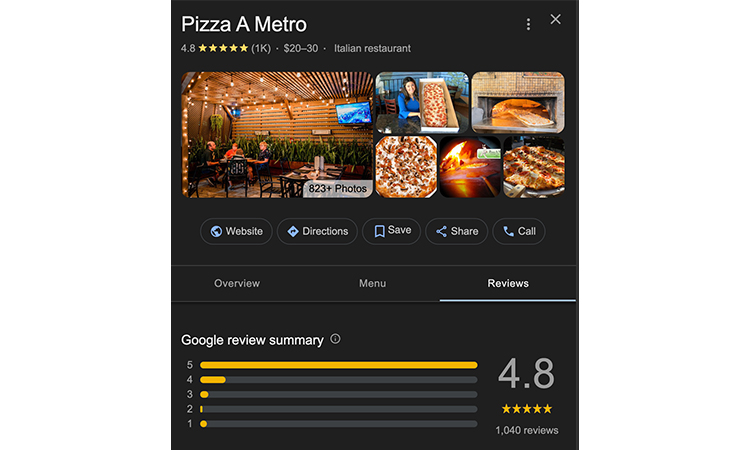
An online reputation management strategy is essential for increasing Google ratings and reviews for a business. When someone types “pizza near me” into Google, the search engine looks at which places have the most positive reviews. If you get more 5-star reviews, it means your store shows up higher in search results, which means that more people find it without ads.
Most importantly, you need to revert all reviews, even if it is negative. Always reply politely and professionally. Try to show your gratitude to your clients; it shows you’re loyal to your customers and care about them. Moreover, it reflects your brand prestige and expresses how responsible you are.

Easy Ways for Chain Stores & Franchises to Handle Reviews & Manage Reputation
1. Monitor All Locations Daily
Use these easy tools:
- Google My Business—Free tool to verify reviews
- Yelp for Business—Sometimes a free review tracker
- BirdEye—a paid tool that watches all locations at once
2. Collect Relevant Local Data
- You need to keep an eye on the places that get the most reviews.
- Check out the shops with the worst reviews.
- Pay attention to what people worry about the most.
3. Respond to Every Review
- Always show your appreciation to your clients within 24 hours.
- Then you need to resolve customer queries and any issues they face. Then you can use their feedback to improve your business and customer satisfaction.
- Try to incorporate your real client’s name in your responses to make them feel more personal and valued.
4. Ask Happy Customers for Reviews
- Check out cards with QR codes on them.
- Send text messages to follow up.
- Teach your staff how to politely ask happy customers
5. Fix Common Problems
If you get complaints from more than one location, you need to address them promptly and find solutions to prevent them from happening in the future. Moreover, you can give your staff better training to resolve issues.
6.Track Sentiment
Moreover, you can use tools like Google Alerts or Brand24 to monitor mentions of your brand in local news outlets, blogs, or forums.
- How to Improve Local Rankings on Google Maps with Advanced Optimization Tactics?
Here are some useful strategies to improve your local SEO for multiple locations.
Embedding Google Maps On Local Pages
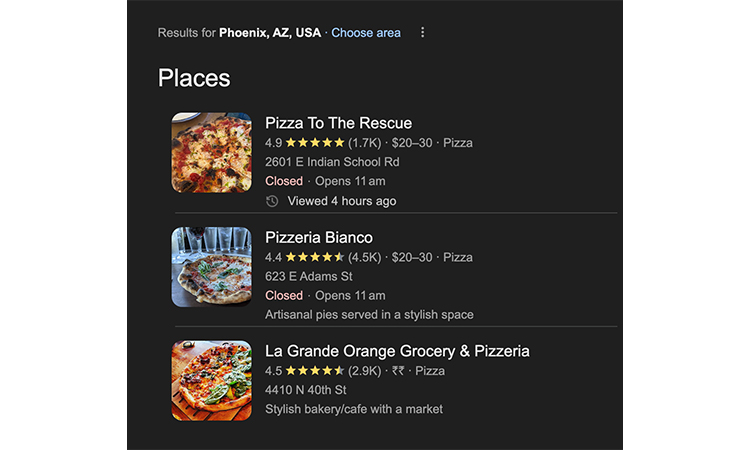
When businesses appear in Google’s local map pack, they receive 93% more calls, clicks, and directions, and 126% more traffic than those that rank 4–10 in search results. When you embed local map packs strategically, it will produce strong user signals, which Google interprets as indicators of location relevance.
Advanced Implementation:
- Add dynamic maps with unique marks that show exactly where you are.
- Include directions from important sites.
- To improve the user experience, add flow info in real time.
- Add the ability to click to call straight from integrated maps.
Optimize for “Directions” and “Near Me” Searches
If a customer is looking for a local business, they are using “Directions” or “Near Me” searches to indicate their geolocation. Google prioritizes maps, GPS, and mobile-friendly results for these queries. If your business isn’t optimized with an accurate address and store location with directions, you’ll miss local customers. Your company will be more visible in Google Maps, Local Pack, and voice searches with specialized optimization. This is even more important for franchises and chain stores because each one needs to show up correctly in local searches in its area.
Localized Social Media Signals Play in Multiple Locations SEO
You have to develop a separate social media account for different local community. Generic business social media accounts don’t pick up on location-specific signals of relevance.
Strategic Implementation:
- Set up social media pages for each big market that are unique to their area.
- Share material with geo-tagged information about local partnerships and events.
- Check-ins based on location and user-generated posts should be encouraged.
- For community growth, make labels that are special to a place.
PR Plays a Crucial Role in Multiple location SEO
Local public relations produces authoritative backlinks and brand mentions that significantly impact local search rankings. Most franchises overlook this factor. But if you utilize PR effectively, you can greatly improve your SEO performance across multiple locations.
Execution Framework:
- Partner with local newspapers and community blogs
- Sponsor local events and charity initiatives.
- Issue location-specific press releases for grand openings.
- Develop relationships with local business associations and chambers of commerce.
Voice Search Optimization Improves “Near Me” Discovery
27% of mobile queries are voice searches, and the majority of them contain location modifiers. So you need to optimize for conversational queries to capture this growing search segment.
Implementation Strategy:
- Focus on long-tail conversational keywords, like “Where’s the closest ____ type of business?”
- Improve your site so that people can ask questions about services and hours.
- Your FAQ should be in simple and easy-to-understand language.
User-Generated Content (UGC) Transforms Local SEO Performance
Customer-generated content shows real local relevance and develops legitimacy and community involvement in many places.
UGC Optimization Tactics:
- Set up review reward programs that encourage in-depth experiences of the place.
- You can create geo-targeted content that resonates with local audiences and encourages them to share their experiences on social media platforms. This will raise your local SEO performance and enhance your brand’s authority and accessibility in multiple locations.
- Put pictures and reviews of happy customers on the pages for each place.
- Then showcase your happy clients’ testimonials on your website and social media profiles.
These advanced techniques go beyond the basics of local SEO to make full optimization plans that exceed local search results by improving the user experience and real community involvement.
- How Can Franchises Build Local Links to Boost Authority?
High-quality Link building is similar to receiving referrals from other websites. When another website puts a link to your business website, it’s like them saying, “Hey, this business is good! These links give your company a more significant and reputable identity in Google’s eyes.
Why Link Building Is Super Important for Franchises?
Think of it like this: If only one person says you’re good at soccer, people might not believe it. But if 20 different people say you’re amazing at soccer, everyone will believe you’re really good! That’s how links work for franchise websites.
When many local websites link to your franchise location, Google thinks, “Wow, this business must be really popular in this town!” This helps your business show up first when people search for things like “pizza near me” or “best hair salon.”
Easy Ways Franchises Can Get Local Links
1. Be Friends with Local Businesses
First, you can partner with companies in the area that aren’t your rivals. They can work together with a nearby movie house. They can put links on their sites that will help people find both of them.
2. Join Local Groups
There are business groups in every town, such as the Chamber of Commerce. When you join one of these groups, they’ll often add a link to your business to their website. It’s like being in the cool kids’ club at school!
3. Help Your Community
Moreover, you can endorse local sports teams, school events, or charity drives. Your company and website are frequently mentioned in articles about these events in the local newspaper.
4. Get in Local News
Do something that will get news! Start a new business, hire locals, or help out in an emergency. Newspapers in the area love to write about companies that do good things in the area.
5. Work with Local Bloggers
Furthermore, you have to look for blog writers who write about your city or town. Offer to help them for free in return for an honest review and a link to your site on theirs.
Moreover, you can identify gaps using Semrush:
- Go to Backlink Analytics and put your domain for overview, anchors, categories, and geos.
- Where Do Accessibility and CX Influence Local SEO Outcomes?
People who can’t see well or move their hands easily should be able to use websites without any problems. Customer experience, or CX, is how pleased people are with a website.
Why Google Cares About These Things?
When a user searches for “dentist near me” (demonstrating local intent), Google tries to give relevant content for all users. Google will not display your website to users searching for local companies if it is complicated to use.
Accessibility Increase Local Search Rankings-
- You need to use a larger font on your website for users to understand it.
- The buttons should be clear so that the user can click them easily. And then they can crawl whichever pages they want.
- Then add alt text to your images. It will help visually challenged persons in recognizing them.
- Google sees them as indicators of a good website.
Special Tips for Multi-Location Brands
Every retail location requires a user-friendly homepage of its own. If there are 20 locations for your pizza business, you need to create local page for each of the 20 locations, which should:
- The website should be optimized for mobile devices.
- Test websites with screen readers.
- Use simple, clear language.
- Your website should be loaded within 3seconds.
- Show clear store addresses.
- Easy navigation helps people find store hours quickly.
- Phone numbers should be easy to read.
- Your local pages and website have to work for people with disabilities.
A website gets more visitors when it works well for everyone. There are more customers at these stores because Google knows this and ranks them higher in local search results.
- When Do You Run a Local SEO Pilot and How Do You Scale Wins?
Local SEO pilots are small-scale test projects that businesses use to see how well their local SEO campaign works in a few locations before putting it in place everywhere. This lowers the risk of failure and raises productivity. You can operate a local SEO pilot when your multi-location businesses face these problems:
- When you get weak local search results in different areas
- Then, if you experience low traffic for important search queries
- Performing differently in different places
Choose 3-5 comparable areas for test sites. Choose shops with average performance, not your best or worst performing company locations.
How to Run the Pilot
Test One Strategy at a Time
Focus your multi-location SEO strategy on:
- Setting up Google Business Profiles entirely.
- Creating location-specific landing pages.
- Developing local citations and directories.
- Getting consumer evaluations regularly
Track Key Metrics
- Local search results rank for target keywords.
- Search keywords that attract clients to each company location.
- Calls and shop visits from internet sources.
- Revenue changes at pilot sites.
Scaling Your Wins
- Step 1: Analyze What Worked-You need to compare the pilot and control positions. Look for commonalities in successful search queries and changes to local search results pages.
- Step 2: Create Standard Processes-Then you should create step-by-step guidance for your successful multi-location SEO strategies. Train teams to imitate effective techniques.
- Step 3: Roll Out Gradually-Apply successful tactics to 10 to 20 sites each month. This avoids overloading your staff while maintaining quality control.
- Step 4: Monitor and Adjust-Keep track of how each company location performs. Some places may need various techniques depending on local competitiveness and client behavior.
Success Tips for Multi-Location Businesses
Start small, test thoroughly, and scale systematically. Your multi-location SEO strategy should treat each location like a unique business location while maintaining brand consistency across all local search results.
- How Should Franchises Manage Brand Consistency Vs Local Flexibility?
It’s hard for franchises and chain stores to keep the same brand everywhere while also fulfilling the customer requirements in each area.
Brand Consistency
Your clients will see the same logo, colors, tone of voice, and quality no matter which store they go to. This is called brand consistency. And you have to maintain this reliability across all locations to establish trust and loyalty with your customers. This will help create a strong brand identity and ensure a positive customer experience, no matter where they interact with your brand. For instance, a California McDonald’s should look and feel like a New York Starbucks. Search engines like clear and consistent business information like name, address, and phone number (NAP). This constructs credibility, keeps the franchises powerful, and raises the profile in search results.
Local Flexibility
Local flexibility means letting each store connect with the people in its own area. Even if a franchise adds local flavor, it can still follow the brand’s rules. One pizza chain might advertise BBQ-style pizzas in Texas and thin-crust deals in New York. This may reach numerous local customers through location-specific keywords and upgrades of your place-specific local pages.
The Balance
It is best to make brand guidelines that all stores must follow, but local pages, online reviews, promotions, and events should be able to be changed as needed. This balance is good for both customers and local SEO strategies.
- Which Compliance and Data Quality Controls Keep Local Listings Clean?
When people type search queries like “Best apparel shop near me.” Google checks if your store information matches everywhere online. When a website has an incorrect address, Google becomes confused and may not display your store to users.
Simple Tools to Keep Information Clean
1. Google My Business Manager
- Controls all your store listings at once
- Updates hours, addresses, and phone numbers
2. Yext
- Fixes wrong information on more than 100 websites automatically
- Instantly sends changes to all listing sites
3. BrightLocal
- Checks if your store info is the same everywhere
- Finds websites with wrong details
Check the following information frequently to hold your brand position on search engines-
- Check store hours—make sure holiday hours are updated.
- Verify addresses—ensure street names are spelled correctly.
- Test phone numbers—confirm all numbers work.
- Monitor reviews—remove fake or spam reviews.
- How To Handle Duplicate Content Challenges Across Multi-Location Pages?
Franchises in multiple locations and chain stores need distinct pages for each place. This is called multiple location SEO. The issue is that Google interprets identical content on multiple pages as duplicate content. Search engines become confused about which page to display when you have duplicate content, which can lower your local search rankings.
So, how do you fix it?
- Use Unique Local Content—You have created in-depth descriptions of each business site. Add neighborhood sites, staff names, or places close by. For example, a pizza shop in New York can mention “Times Square,” while the same brand in Los Angeles can mention “Hollywood.”
- Add Location-Specific Keywords—Then you can put area-specific keywords like “Pizza in Dallas” or “Pizza in Chicago,” which should be different on each page. Your multiple landing pages will be distinct for this separate content.
- Use Google Business Profile and Maps— You have to pair each page with its Google Business Page and show the correct NAP (Name, Address, Phone).
- Avoid Copy-Paste— Don’t ever copy one page’s description or content word-for-word onto another page. This will help improve your search engine rankings and prevent duplicate content penalties. Moreover, you can apply local reviews and testimonials—include testimonials from customers in each specific location to show authenticity and legitimacy to potential customers in that area.
- Where Does AI and Automation Fit Into Multi-Location SEO?
Artificial intelligence (AI) helps franchises and chain stores with multiple locations handle all the online work automatically, much like a magic assistant that updates 100 stores at once!
The following Smart Tools Help Your Business Operate in Multiple locations
AI-Powered Tools
- ChatGPT/Claude -You can write descriptions for each store location with this AI tool.
- Synup: Identifies and automatically corrects incorrect store information.
- Rio SEO—Updates store hours across 200+ websites quickly. This tool can save businesses time and resources by efficiently managing multiple store locations.
- SOCi— Produces social media content for every location
- Reputation.com – Responds to customer reviews automatically and helps businesses maintain a positive online reputation.
Automation Tools
- Google My Business API: Reveals all store information together
- Hootsuite—Posts on social media for every location
- Podium – Generates automatic text messages to customers
- BirdEye—Asks customers for reviews automatically
Simple Steps to Use AI for Your Stores
Step 1: Set Up Smart Tracking
- Link all of your stores to a single platform.
- If the store’s hours or site changes, let AI know.
Step 2: Automate Content Creation
- You can use AI to write summaries for each store.
- Then you should take the information and new ideas and write posts about events in your neighborhood.
Step 3: Smart Review Management
- AI reads all reviews and lets you know when something is wrong.
- Customers will be automatically recognized for good reviews.
Step 4: Local Content Automation
- AI writes posts about news, events, or the weather in your area.
- AI will guide you on when to post on social media sites.
Step 5: Monitor Performance
- AI tracks which stores get the most online visitors.
- Shows which locations need more help
Why This Helps Your Franchises or Chain Stores?
One person managing 50 shops manually takes forever; AI accomplishes it in minutes. This means:
- All stores stay updated with correct information.
- More customers find your locations online.
- You save time and money.
- Every location gets equal attention.
- What 90-Day Action Plan Kicks Off Local SEO For Multiple Locations?
- Week 1–2: audits (GBP, listings, technical, content)
- Week 3–6: store locator rebuild, top-20 location page templates, review engine
- Week 7–10: citation clean-up, category/product sync, schema
- Week 11–13: PR + community links, testing, reporting setup
How to Keep Your Multiple Location SEO Safe from Google Changes?
Establish a Strong Store Identity Online
- Google prefers companies with comprehensive, transparent information. Give each online store its name to make an entity-first architecture.
- You can get store-level knowledge panels by giving each location full information. Moreover, you can add manager names, special services, and local community participation. Google highlights these detailed boxes when people search.
Own Your Customer Information
- Then you may accumulate first-party data directly from customers through apps, email lists, and loyalty programs. You can still talk to customers directly even if Google changes how search works.
- Furthermore, you can put crucial information in search results for zero-click searches. Display shop hours, pricing, and contact information without clicking.
Prepare for Smart Search
- After that, you can prepare for AI overviews to produce simple content that responds to frequently asked queries. When people ask, “Where is the nearest Target?” your information should be easy for AI to understand and share. Make sure to optimize your content for voice search as well.
- So you have to develop structured data resilience using special code that indicates to Google exactly what your business offers. This provides store hours, services, prices, and reviews in a format computers understand flawlessly.
These methods protect your stores no matter how Google changes its rules.
Frequently Asked Questions- Local SEO for Multiple Locations
A small business usually spends between $501 and $1,000 a month on local SEO. The typical hourly rate for local SEO services is $128. Professional local SEO is affordable compared to other marketing services.
Duplicate content problems happen when the same content is used on all location pages. To do well in local search results, each location page needs its own description, local keywords, customer reviews, staff information, and information about the area.
Multiple location SEO typically takes 3-6 months to show real results and best ROI after 8-12 months. New locations need longer, while established franchises see faster improvements in local rankings and customer calls.
Last Words Before We Go
So, we are at the end of our discussion of local SEO for multiple locations. I hope this information helped optimize your business’s online presence. Being a franchise or chain store business owner, you have to implement a multi-location SEO strategy. If you want to optimize local SEO for various areas, you should ensure that each location has its own unique landing page with relevant content and keywords. Though you manage these local SEO campaigns on your own, the professional SEO expert can guide you with their expertise.
Various digital marketing companies can help you create and implement a successful multi-location SEO strategy customized to your business needs. You can make sure that each location is properly optimized for maximum online visibility and customer engagement by hiring a professional.
Don’t wait too much; go and implement the above-mentioned local SEO for multiple locations approaches and be a witness to something revolutionary in your franchise or chain store business.

